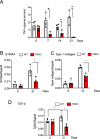VEGFR1-tyrosine kinase signaling in pulmonary fibrosis
- PMID: 34082837
- PMCID: PMC8173728
- DOI: 10.1186/s41232-021-00166-7
VEGFR1-tyrosine kinase signaling in pulmonary fibrosis
Abstract
Vascular endothelial growth factor (VEGF) is not only an important factor for angiogenesis but also lung development and homeostasis. VEGF-A binds three tyrosine kinase (TK) receptors VEGFR1-3. Idiopathic pulmonary fibrosis (IPF) is one of the poor prognoses of lung diseases. The relationship of VEGF and IPF remains to be clarified. Treatment with nintedanib used for the treatment of IPF reduced fibroblast proliferation, inhibited TK receptors, platelet-derived growth factor receptor (PDGFR), fibroblast growth factor receptor (FGFR), and VEGFR. Because the effect of that treatment is still not satisfactory, the emergence of new therapeutic agents is needed. This review describes the enhancement of pulmonary fibrosis by VEGFR1-TK signal and suggests that the blocking of the VEGFR1-TK signal may be useful for the treatment of pulmonary fibrosis.
Keywords: CXCR4; Pulmonary fibrosis; SDF-1; VEGFR1+ cells; VEGFR1-TK.
Conflict of interest statement
The authors declare that they have no competing interests.
Figures




Similar articles
-
The role of vascular endothelial growth factor receptor 1 tyrosine kinase signaling in bleomycin-induced pulmonary fibrosis.Biomed Pharmacother. 2019 Sep;117:109067. doi: 10.1016/j.biopha.2019.109067. Epub 2019 Jun 5. Biomed Pharmacother. 2019. PMID: 31176171
-
Anti-fibrotic effects of nintedanib in lung fibroblasts derived from patients with idiopathic pulmonary fibrosis.Respir Res. 2014 Dec 12;15(1):157. doi: 10.1186/s12931-014-0157-3. Respir Res. 2014. PMID: 25496490 Free PMC article.
-
Nintedanib modulates surfactant protein-D expression in A549 human lung epithelial cells via the c-Jun N-terminal kinase-activator protein-1 pathway.Pulm Pharmacol Ther. 2015 Jun;32:29-36. doi: 10.1016/j.pupt.2015.03.001. Epub 2015 Apr 2. Pulm Pharmacol Ther. 2015. PMID: 25843005
-
The role of tyrosine kinases in the pathogenesis of idiopathic pulmonary fibrosis.Eur Respir J. 2015 May;45(5):1426-33. doi: 10.1183/09031936.00149614. Epub 2015 Mar 5. Eur Respir J. 2015. PMID: 25745048 Review.
-
Nintedanib (OFEV) in the treatment of idiopathic pulmonary fibrosis.Expert Rev Respir Med. 2016 Dec;10(12):1247-1254. doi: 10.1080/17476348.2016.1249854. Epub 2016 Oct 31. Expert Rev Respir Med. 2016. PMID: 27744713 Review.
Cited by
-
Polydatin-curcumin formulation alleviates CTD-ILD-like lung injury in mice via GABBR/PI3K/AKT/TGF-β pathway.Front Pharmacol. 2025 Jun 5;16:1573525. doi: 10.3389/fphar.2025.1573525. eCollection 2025. Front Pharmacol. 2025. PMID: 40538533 Free PMC article.
-
Integrating inflammatory biomarker analysis and artificial-intelligence-enabled image-based profiling to identify drug targets for intestinal fibrosis.Cell Chem Biol. 2023 Sep 21;30(9):1169-1182.e8. doi: 10.1016/j.chembiol.2023.06.014. Epub 2023 Jul 11. Cell Chem Biol. 2023. PMID: 37437569 Free PMC article.
-
Knockdown of lncRNA PVT1 protects human trabecular meshwork cells against H2O2-induced injury via the regulation of the miR-29a-3p/VEGF/MMP-2 axis.Heliyon. 2023 Dec 12;10(1):e23607. doi: 10.1016/j.heliyon.2023.e23607. eCollection 2024 Jan 15. Heliyon. 2023. PMID: 38173510 Free PMC article.
-
Virtual screening and activity evaluation of multitargeting inhibitors for idiopathic pulmonary fibrosis.Front Pharmacol. 2022 Sep 8;13:998245. doi: 10.3389/fphar.2022.998245. eCollection 2022. Front Pharmacol. 2022. PMID: 36160399 Free PMC article.
-
Non-Coding RNAs in Pulmonary Diseases: Comparison of Different Airway-Derived Biosamples.Int J Mol Sci. 2023 Jan 19;24(3):2006. doi: 10.3390/ijms24032006. Int J Mol Sci. 2023. PMID: 36768329 Free PMC article. Review.
References
-
- Oishi Y, Manabe I. Macrophages in inflammation, repair and regeneration. Int Immunol. 2018;30:511–529. - PubMed
Publication types
LinkOut - more resources
Full Text Sources
Miscellaneous

